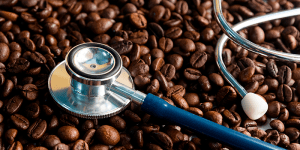Café previene eventos tempranos en pacientes con cáncer de mama tratadas con tamoxifeno y modula el estado del receptor hormonal
27-04-2017
Este trabajo tuvo como objetivo investigar el impacto del consumo de café en las características tumorales y riesgo de eventos tempranos en relación con el tratamiento de cáncer de seno, estimando la presencia de genotipos CYP1A2 Y CYP2C8, la cual podría confundir la asociación. Un estudio de cohorte fue adelantado aplicando un cuestionario sobre estilo de vida a 634 pacientes en el sur de Suecia quienes iban a ser intervenidos quirúrgicamente. La presencia de los citocromos CYP1A2*1F y CYP2C8*3 fue genotipificada en cada paciente. Los datos clínicos y características del tumor fueron obtenidos de los registros de los pacientes, registros demográficos, e informes de patología. El consumo de café fue clasificado en las siguientes categorías: bajo (0-1 tazas/día), moderado (2-4 tazas/día), o alto (5 + tazas/día). La proporción de tumores receptor de estrógeno negativos (ER-) aumentó con el aumento de consumo de café (p = 0.042). El consumo moderado a alto fue asociado con una frecuencia inferior en el status de receptor discordante (ER + PgR-) OR 0.38 (0.23-0.63) comparado con un consumo bajo de café. El tiempo de seguimiento promedio fue 4.92 (IQR 3.01-6.42) años. Los pacientes tratados con tamoxifeno con tumores ER + (n = 310) que consumieron dos o más tazas/día presentan una disminución del riesgo considerable de eventos tempranos comparados con pacientes cuyo consumo fue bajo, HR ajustado fue 0.40 (0.19-0.83). El consumo bajo combinado con al menos un alelo CYP1A2*1F C (n = 35) o CYP2C8*3 (n = 13) fue asociado con un alto riesgo para eventos tempranos en pacientes tratados con tamoxifeno comparado con otros pacientes tratados con tamoxifeno, HR ajustado 3.49 (1.54-7.91) y 6.15 (2.46-15.36), respectivamente. CONCLUSIÓN: Un consumo moderado a alto de café está asociado con una reducción significativa de riesgo de eventos tempranos en pacientes tratados con tamoxifeno y con status de receptor hormonal modificado. De ser confirmado, nuevas recomendaciones en cuanto al consumo de café durante el tratamiento con tamoxifeno podrían ser realizadas.
Simonsson M, Soderlind V, Henningson M, Hjertberg M, Rose C, Ingvar C, Jernstrom H. Coffee prevents early events in tamoxifen-treated breast cancer patients and modulates hormone receptor status. Cancer Causes Control 2013, 24: 929-940.
The National Board of Health and Welfare (2011) Cancer incidence in Sweden 2010. http://www.socialstyrelsen.se/Lists/Artikelkatalog/Attachments/18530/2011-12-15.pdf
Fernö M, Borg Å, Johansson U, Norgren A, Olsson H, Ryden S, Sellberg G (1990) Estrogen and progesterone receptor analyses in more than 4,000 human breast cancer samples. A study with special reference to age at diagnosis and stability of analyses. Southern Swedish Breast Cancer Study Group. Acta Oncol 29(2):129–135 CrossRef
Larsson SC, Bergkvist L, Wolk A (2009) Coffee and black tea consumption and risk of breast cancer by estrogen and progesterone receptor status in a Swedish cohort. Cancer Causes Control 20(10):2039–2044. doi:10.1007/s10552-009-9396-x CrossRef
Conzen SD (2008) Minireview: nuclear receptors and breast cancer. Mol Endocrinol 22(10):2215–2228. doi:10.1210/me.2007-0421 CrossRef
Osborne CK, Schiff R (2011) Mechanisms of endocrine resistance in breast cancer. Annu Rev Med 62:233–247. doi:10.1146/annurev-med-070909-182917 CrossRef
Li J, Seibold P, Chang-Claude J, Flesch-Janys D, Liu J, Czene K, Humphreys K, Hall P (2011) Coffee consumption modifies risk of estrogen-receptor negative breast cancer. Breast Cancer Res 13(3):R49. doi:10.1186/bcr2879 CrossRef
The European Coffee Federation (2010) The European coffee report, vol 2011. The European Coffee Federation. http://www.scribd.com/doc/45025346/European-Coffee-Report-2009
Allred KF, Yackley KM, Vanamala J, Allred CD (2009) Trigonelline is a novel phytoestrogen in coffee beans. J Nutr 139(10):1833–1838. doi:10.3945/jn.109.108001 CrossRef
Michels KB, Holmberg L, Bergkvist L, Wolk A (2002) Coffee, tea, and caffeine consumption and breast cancer incidence in a cohort of Swedish women. Ann Epidemiol 12(1):21–26 CrossRef
Freedman ND, Park Y, Abnet CC, Hollenbeck AR, Sinha R (2012) Association of coffee drinking with total and cause-specific mortality. N Engl J Med 366(20):1891–1904. doi:10.1056/NEJMoa1112010 CrossRef
Svenska bröstcancergruppen (2011) Nationella riktlinjer 2011, vårdprogram.. http://www.swebcg.se/Files/Docs/Nationella_riktlinjer110131.pdf. Accessed 20110512 2011
Jordan VC, Koerner S (1975) Tamoxifen (ICI 46,474) and the human carcinoma 8S oestrogen receptor. Eur J Cancer 11(3):205–206
Jin Y, Desta Z, Stearns V, Ward B, Ho H, Lee KH, Skaar T, Storniolo AM, Li L, Araba A, Blanchard R, Nguyen A, Ullmer L, Hayden J, Lemler S, Weinshilboum RM, Rae JM, Hayes DF, Flockhart DA (2005) CYP2D6 genotype, antidepressant use, and tamoxifen metabolism during adjuvant breast cancer treatment. J Natl Cancer Inst 97(1):30–39. doi:10.1093/jnci/dji005 CrossRef
Dunn BK, Greene MH, Kelley JM, Costantino JP, Clifford RJ, Hu Y, Tang G, Kazerouni N, Rosenberg PS, Meerzaman DM, Buetow KH (2010) Novel pathway analysis of genomic polymorphism-cancer risk interaction in the breast cancer prevention trial. Int J Mol Epidemiol Genet 1(4):332–349
Chen J, Halls SC, Alfaro JF, Zhou Z, Hu M (2004) Potential beneficial metabolic interactions between tamoxifen and isoflavones via cytochrome P450-mediated pathways in female rat liver microsomes. Pharm Res 21(11):2095–2104 CrossRef
Andersson H, Helmestam M, Zebrowska A, Olovsson M, Brittebo E (2010) Tamoxifen-induced adduct formation and cell stress in human endometrial glands. Drug Metab Dispos 38(1):200–207. doi:10.1124/dmd.109.029488 CrossRef
Kot M, Daniel WA (2008) The relative contribution of human cytochrome P450 isoforms to the four caffeine oxidation pathways: an in vitro comparative study with cDNA-expressed P450 s including CYP2C isoforms. Biochem Pharmacol 76(4):543–551. doi:10.1016/j.bcp.2008.05.025 CrossRef
Bågeman E, Ingvar C, Rose C, Jernström H (2008) Coffee consumption and CYP1A2*1F genotype modify age at breast cancer diagnosis and estrogen receptor status. Cancer Epidemiol Biomarkers Prev 17(4):895–901. doi:10.1158/1055-9965.EPI-07-0555 CrossRef
Sachse C, Brockmoller J, Bauer S, Roots I (1999) Functional significance of a C–>A polymorphism in intron 1 of the cytochrome P450 CYP1A2 gene tested with caffeine. Br J Clin Pharmacol 47(4):445–449 CrossRef
Djordjevic N, Ghotbi R, Jankovic S, Aklillu E (2010) Induction of CYP1A2 by heavy coffee consumption is associated with the CYP1A2 -163C > A polymorphism. Eur J Clin Pharmacol 66(7):697–703. doi:10.1007/s00228-010-0823-4 CrossRef
Jernström H, Bågeman E, Rose C, Jönsson PE, Ingvar C (2009) CYP2C8 and CYP2C9 polymorphisms in relation to tumour characteristics and early breast cancer related events among 652 breast cancer patients. Br J Cancer 101(11):1817–1823. doi:10.1038/sj.bjc.6605428 CrossRef
Ringberg A, Bågeman E, Rose C, Ingvar C, Jernström H (2006) Of cup and bra size: reply to a prospective study of breast size and premenopausal breast cancer incidence. Int J Cancer 119(9):2242–2243. Author reply 2244. doi:10.1002/ijc.22104
Osborne CK, Yochmowitz MG, Knight WA 3rd, McGuire WL (1980) The value of estrogen and progesterone receptors in the treatment of breast cancer. Cancer 46(12 Suppl):2884–2888 CrossRef
Cui X, Schiff R, Arpino G, Osborne CK, Lee AV (2005) Biology of progesterone receptor loss in breast cancer and its implications for endocrine therapy. J Clin Oncol 23(30):7721–7735.
doi:10.1200/JCO.2005.09.004 CrossRef
Bardou VJ, Arpino G, Elledge RM, Osborne CK, Clark GM (2003) Progesterone receptor status significantly improves outcome prediction over estrogen receptor status alone for adjuvant endocrine therapy in two large breast cancer databases. J Clin Oncol 21(10):1973–1979. doi:10.1200/JCO.2003.09.099 CrossRef
Hashimoto T, He Z, Ma WY, Schmid PC, Bode AM, Yang CS, Dong Z (2004) Caffeine inhibits cell proliferation by G0/G1 phase arrest in JB6 cells. Cancer Res 64(9):3344–3349 CrossRef
Cui X, Zhang P, Deng W, Oesterreich S, Lu Y, Mills GB, Lee AV (2003) Insulin-like growth factor-I inhibits progesterone receptor expression in breast cancer cells via the phosphatidylinositol 3-kinase/Akt/mammalian target of rapamycin pathway: progesterone receptor as a potential indicator of growth factor activity in breast cancer. Mol Endocrinol 17(4):575–588. doi:10.1210/me.2002-0318 CrossRef
Divekar SD, Storchan GB, Sperle K, Veselik DJ, Johnson E, Dakshanamurthy S, Lajiminmuhip YN, Nakles RE, Huang L, Martin MB (2011) The role of calcium in the activation of estrogen receptor-alpha. Cancer Res 71(5):1658–1668. doi:10.1158/0008-5472.CAN-10-1899 CrossRef
Caldarella A, Crocetti E, Bianchi S, Vezzosi V, Urso C, Biancalani M, Zappa M (2011) Female breast cancer status according to ER, PR and HER2 expression: a population based analysis. Pathol Oncol Res. doi:10.1007/s12253-011-9381-z
Jernström H, Klug TL, Sepkovic DW, Bradlow HL, Narod SA (2003) Predictors of the plasma ratio of 2-hydroxyestrone to 16alpha-hydroxyestrone among pre-menopausal, nulliparous women from four ethnic groups. Carcinogenesis 24(5):991–1005 CrossRef
Bradlow HL, Jernström H, Sepkovic DW, Klug TL, Narod SA (2006) Comparison of plasma and urinary levels of 2-hydroxyestrogen and 16 alpha-hydroxyestrogen metabolites. Mol Genet Metab 87(2):135–146. doi:10.1016/j.ymgme.2005.08.001 CrossRef
Klug TL, Bågeman E, Ingvar C, Rose C, Jernström H (2006) Moderate coffee and alcohol consumption improves the estrogen metabolite profile in adjuvant treated breast cancer patients: a pilot study comparing pre- and post-operative levels. Mol Genet Metab 89(4):381–389. doi:10.1016/j.ymgme.2006.08.005 CrossRef
Schneider J, Huh MM, Bradlow HL, Fishman J (1984) Antiestrogen action of 2-hydroxyestrone on MCF-7 human breast cancer cells. J Biol Chem 259(8):4840–4845
Telang NT, Suto A, Wong GY, Osborne MP, Bradlow HL (1992) Induction by estrogen metabolite 16 alpha-hydroxyestrone of genotoxic damage and aberrant proliferation in mouse mammary epithelial cells. J Natl Cancer Inst 84(8):634–638 CrossRef
Thibodeau PA, Bissonnette N, Bedard SK, Hunting D, Paquette B (1998) Induction by estrogens of methotrexate resistance in MCF-7 breast cancer cells. Carcinogenesis 19(9):1545–1552 CrossRef
Lee AJ, Cai MX, Thomas PE, Conney AH, Zhu BT (2003) Characterization of the oxidative metabolites of 17beta-estradiol and estrone formed by 15 selectively expressed human cytochrome p450 isoforms. Endocrinology 144(8):3382–3398 CrossRef
Berthou F, Flinois JP, Ratanasavanh D, Beaune P, Riche C, Guillouzo A (1991) Evidence for the involvement of several cytochromes P-450 in the first steps of caffeine metabolism by human liver microsomes. Drug Metab Dispos 19(3):561–567
Bahadur N, Leathart JB, Mutch E, Steimel-Crespi D, Dunn SA, Gilissen R, Houdt JV, Hendrickx J, Mannens G, Bohets H, Williams FM, Armstrong M, Crespi CL, Daly AK (2002) CYP2C8 polymorphisms in Caucasians and their relationship with paclitaxel 6alpha-hydroxylase activity in human liver microsomes. Biochem Pharmacol 64(11):1579–1589 CrossRef
Larsson SC, Giovannucci E, Wolk A (2006) Coffee consumption and stomach cancer risk in a cohort of Swedish women. Int J Cancer 119(9):2186–2189. doi:10.1002/ijc.22105 CrossRef
Jernström H, Frenander J, Fernö M, Olsson H (1999) Hormone replacement therapy before breast cancer diagnosis significantly reduces the overall death rate compared with never-use among 984 breast cancer patients. Br J Cancer 80(9):1453–1458. doi:10.1038/sj.bjc.6690543 CrossRef
Schuetz F, Diel IJ, Pueschel M, von Holst T, Solomayer EF, Lange S, Sinn P, Bastert G, Sohn C (2007) Reduced incidence of distant metastases and lower mortality in 1072 patients with breast cancer with a history of hormone replacement therapy. Am J Obstet Gynecol 196(4):342 e341–349.
doi:10.1016/j.ajog.2006.10.901
Nanda K, Bastian LA, Schulz K (2002) Hormone replacement therapy and the risk of death from breast cancer: a systematic review. Am J Obstet Gynecol 186(2):325–334 CrossRef
Stahlberg C, Lynge E, Andersen ZJ, Keiding N, Ottesen B, Rank F, Hundrup YA, Obel EB, Pedersen AT (2005) Breast cancer incidence, case-fatality and breast cancer mortality in Danish women using hormone replacement therapy–a prospective observational study. Int J Epidemiol 34(4):931–935. doi:10.1093/ije/dyi103 CrossRef
Chlebowski RT, Anderson GL, Gass M, Lane DS, Aragaki AK, Kuller LH, Manson JE, Stefanick ML, Ockene J, Sarto GE, Johnson KC, Wactawski-Wende J, Ravdin PM, Schenken R, Hendrix SL, Rajkovic A, Rohan TE, Yasmeen S, Prentice RL (2010) Estrogen plus progestin and breast cancer incidence and mortality in postmenopausal women. JAMA 304(15):1684–1692. doi:10.1001/jama.2010.1500 CrossRef
Markkula A, Hietala M, Henningson M, Ingvar C, Rose C, Jernström H (2012) Clinical profiles predict early nonadherence to adjuvant endocrine treatment in a prospective breast cancer cohort. Cancer Prev Res (Phila) 5(5):735–745. doi:10.1158/1940-6207.CAPR-11-0442 CrossRef















